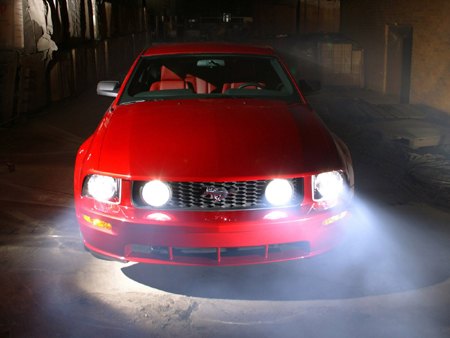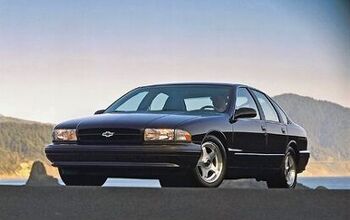Profit of Doom
Ford and GM are launching summer sales. The development reveals an open secret: the automakers are selling vehicles at a loss. There are plenty of reasons for this. The need to maintain cash flow, pay the Union, generate business for their finance arms and protect market share. But this trend can’t continue indefinitely. At some point, both of these companies need to produce profitable vehicles, and lots of ‘em. But what kind?
Back in the “good old days”, Detroit made its profits with middle and high end cars and pickup trucks. The Big Three only built small cars when recession and imports forced their hand. And no wonder: there wasn’t any “real money” in small cars– at least not for Detroit. Their bureaucratic manufacturing infrastructure and union obligations made it difficult to compete with smaller, leaner competitors. Besides, it wasn’t much more expensive to design or build a big vehicle than a small one, and they always sold for more money.
Eventually, American automakers surrendered the low-end domestic car market to the Japanese, Koreans and Germans. As the years went by, the foreign competition gradually moved its products up-market. Eventually, the Dai San launched luxury brands, created out of whole cloth (or leather). These were worrisome developments, but dismissible. Then, calamity: Detroit struck gold.
The SUV boom provided a serendipitous boost to the domestics’ bottom-line. The ability to sell cheap-to-build vehicles at a premium price was worth billions (and funded a large number of dubious foreign acquisitions). The SUV-fuelled “easy money” diverted The Big Three’s attention at the precise moment when non-Detroit brands were making serious inroads into the heart of the car market. Now that the SUV market has cooled, the Big Two are left playing catch-up, looking for a new cash cow. Unfortunately, the US car market has changed.
The middle market now belongs to the Japanese. Before the SUV boom, the Ford Taurus was a major force. Its two replacements, the Fusion and the Five Hundred, haven’t exactly set the class on fire. Although the Mexican-built Fusion is a solid sales success, it’s smaller and cheaper than its predecessor; which doesn’t bode well for profitability. The Five Hundred is big and plush and augurs more profit potential. But sales have been weak. GM wishes it had cars as distinctive (if underdone) as these. Meanwhile, Toyota, Nissan and Honda are banking huge profits on highly-evolved– and continually evolving– mid-market motors.
The size class above the middle has lost much of its volume and premium models to the SUV boom. The “near luxury” class is also packed with killer competition. BMW, Mercedes, Lexus and Audi have all reached down– joining Infiniti and Acura on their way up. This combination of superb products, badge snobbery and customer service has marginalized Cadillac and especially Lincoln. It’s worse yet for Buick. And Pontiac. And Mercury. And Saab. It’s hard to see what Ford or GM could do in the “near luxury” market to end well-earned “foreign” hegemony. Even when The Big Two own a successful niche player (Volvo), fierce competition in the segment makes for slim margins.
And then there’s the crisis looming in the truck market. Toyota and Nissan are bringing out new full-size trucks and ramping-up production capacity. The same industry wags who said building small domestic cars was a waste of time now say US truck buyers are too brand loyal to defect to the new guys. GM and Ford better hope so; neither company is in any condition to engage in an extended price war, and the loss of profits would be catastrophic to the rest of their holdings.
So where are the new “profit centers?” Only two American cars are enjoying strong, profitable sales success: the Ford Mustang and the Chrysler 300 (and its Dodge cousins). GM is planning a new Camaro to challenge the Mustang and maybe a rear-drive platform to challenge the 300. But both the Mustang and the 300 have no direct competition at present, making the new models’ potential success hard to judge. New, boldly-styled rear-wheel drive sedans may only fragment the existing market, rather than extend a profitable niche.
Which raises a scary question: even if Ford and GM come up with a hit vehicle or two, will they deliver life-sustaining profits? A spot on the top ten list may guarantee profitability, but the ever-expanding number of product niches– and the number of automakers in each niche– makes it harder for any one product to achieve large (i.e. profitable) volumes. The twin solutions: flexible manufacturing and foreign sales. Neither of which are Ford and GM’s strong suit. In fact, GM and Ford’s best chance for profit now lies in creating a spread of must-have vehicles in smaller runs. This strategy requires some serious money, which can only be generated by profits. Uh-oh.
More by Andrew Dederer
Latest Car Reviews
Read moreLatest Product Reviews
Read moreRecent Comments
- Dale Quelle surprise.
- 3SpeedAutomatic Nice looking, but IIRC, there was an issue with these engines where a knock would develop. That may account for the very low milage. 🚗🚗🚗
- Redapple2 Used to watch F 1 a great deal. Now? F1 Random thoughts:1 Silly rules bug me. Must use 2 types of tire. Cant refuel. Drag reduction can only be used in certain areas of the track and only if you are so close to the car in front.2 Passing is rare. Pole sitter wins a high % of the time.3 A new team can only start in F1 if they get the blessing of the overlords. Evil gm Vampire was barred. How about this. Anybody with a car that meets the construction rules can try. If your speed qualifies and you pay the entry fee. You re in. So is anybody else. 4 I tune in for Martin Brundle's grid walk. In my life, it s must see tv. But he is often bumped or cancelled. Grid walk takes place 1 out of 3 or 4 races.5 So, because of this utter bull sheet and other points, I ve migrated to IMSA and MotoGP. I might catch a summary on the youtube.
- Redapple2 I retract my comments and apologize.
- Flashindapan I always thought these look nice. I was working at a Land Rover dealership at the time the LR3 came out and we were all impressed how much better it was then the Discovery in just about every measurable way.


































Comments
Join the conversation
Dave Clark, I have to disagree with you about the (minor) differences between the 300C, Magnum, and Charger. Tehy are closer than kissing cousins, however only the 300 offers any level of sophisticated style. Too back they don't carry a wagon variant here like they do in Europe. That said, I'm seeing more and more of the 300's pile up at the local dealer - 200 plus now - I think the "gotta have" crowd has moved on. Mustang GTs are a little harder to get, but the 6 cyls are all over the place. Finally, I look forward to purchasing a Mustang GT in the next 2 years...hopefully by then the interior plastics will improve, along with the appearance of satellite radion, steering wheel controls, and the disappearance of the radio mast. I can only hope.
Your timeline is a bit off. GM bought Saab and Ford bought Jaguar right at the beginning of the SUV boom, before it had started generating serious profits. They and Chrysler also diversified in more or less questionable ways back in the 1980s: Hughes, EDS, Gulfstream, etc. So their attention was diverted prior to the SUV boom. Many might argue that they never had a proper focus to be diverted from.